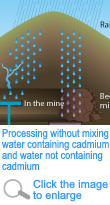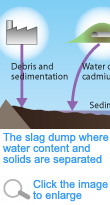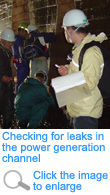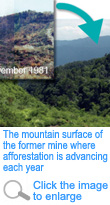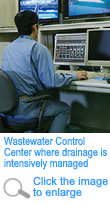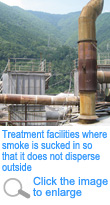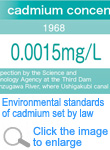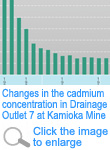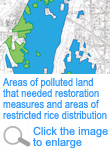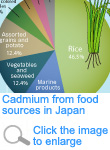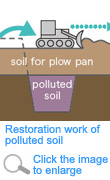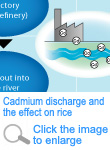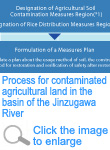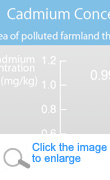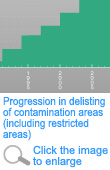安全・安心情報
トップページ > くらし・健康・教育 > 健康・医療・福祉 > 医療 > イタイイタイ病資料館 > 利用案内 > The Itai-itai Disease museum > The Itai-itai Disease museum《FloorPlan》 > Taking back the beautiful water and land by the countermeasures against environmental damage
更新日:2021年3月25日
ここから本文です。
Taking back the beautiful water and land by the countermeasures against environmental damage
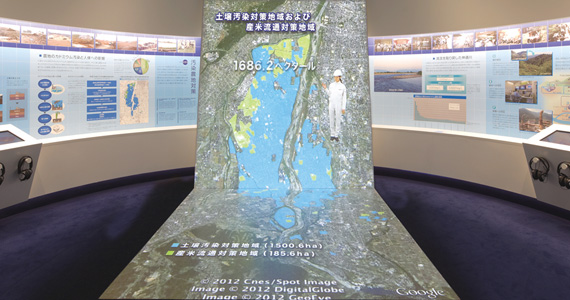



After the trial of Itai-itai Disease, "countermeasures at the origin" such as on-site inspection in Kamioka Mine, and "countermeasures for polluted farmland" such as land restoration work of contaminated rice fields were decided to be conducted. By these kinds of efforts being carried on for many years, the Jinzugawa River and its basin are reclaiming their past beauty.


In order to never let Itai-itai Disease happen again, we need to carry out countermeasures at Kamioka Mine, the origin of cadmium contamination. For this purpose, the affected residents carry out on-site inspections and make requests for improvement to Kamioka Mine with the cooperation of experts still today. Furthermore, Mitsui Mining & Smelting Company also vigorously follows through for improvement.


According to the agreement of prevention of public hazard concluded between residents and Mitsui Mining & Smelting Co., on-site inspections by survey groups consisting of residents and experts have been conducted every year since 1972. There are two kinds of on-site inspections: “whole on-site inspection” conducted once a year for checking the mine as a whole, and “specialty on-site inspection” conducted 6 to 7 times a year for detailed checks. Since the first inspection, the total number of participants reaches 6,000 as of 2011.
At present Kamioka Mine produces zinc and lead from imported minerals or recycled batteries. At on-site inspections, they check if the cadmium in the slag, the exhaust water and smoke from these processes, and in the water of resting or abandoned mines are being disposed properly. Based on the on-site inspections and request of residents, Mitsui Mining & Smelting Company is making improvements to various facilities.
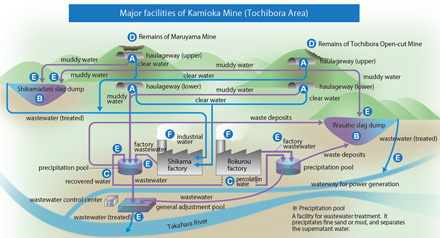
A. Mine water treatment
Some of the water from former mines has high cadmium content, while some of the water has almost none, and these two types are precisely separated. We check the treatment methods as well as the water quality.
B. Slag treatment
Kamioka Mine has a dump where the slag (mineral mine waste) is kept. There is a settling pond for separating watery slag into solid material and liquid, and we examine the quality of separated water and percolation water.
C. Response to leakage into the waterway for power generation
As the polluted water from the factory had contaminated the underground waterway to the power plant, the company is conducting countermeasures such as rebuilding facilities, installing equipmentfor collecting waste water, and pumping up the subsurface water of the old facilities.
D. Restoration of nature
The rough mountain surface around the former mines and waste dumps are reshaped in order to prevent collapse, trees are planted, and polluted water containing cadmium is prevented from flowing out. The size of the planting area reached 75 ha and on many mountain surfaces greenery has been restored.
E. Water exhaust treatment
We check the measures for the treatment of water exhaust. We also conduct periodic water quality checks at the seven water outlets of Kamioka Mine and the water system of the Jinzugawa River.
F. Smoke exhaust treatment
We are moving forward with countermeasures for the smoke containing heavy metals that is produced in the refining process of zinc and lead. Especially since the exhaust smoke from the refining process of zinc contained cadmium, we changed the drying method of slag to the method of squeezing wet slag so as to not make exhaust smoke. We are currently taking regul ar measurements to confirm the outcome.

The effort toward improvement of pollution prevention by the residents and Mitsui Mining & Smelting Company became the first of its kind in the world. As a result, the cadmium levels of the Jinzugawa River are successfully far below the environmental benchmark set by the government, meaning that we have reclaimed the original natural environment. Also, being conscious of pollution prevention and seriously becoming involved with environmental measures has led to a good reputation for the company.

After the completion of the Itai-itai Disease trial, the farmland contaminated by cadmium remained a major issue. The prefecture identified an area exceeding 1,600ha as farmland needing contamination treatment, and land restoration work on polluted land was conducted in order for it to be possible to grow rice in those areas again. As the result of long years of work, restoration of a nationally unprecedented large area of farmland was completed.

At identified farmlands in the area, restoration work was conducted to remove pollution. There were two kinds of methods employed: “method of embedding soil of another place” and “method of topping up soil of another place”, and they were used according to land condition. In addition, maintenance work was conducted together with soil restoration work.

Cadmium discharged into rivers from factories is carried to rice fields by agricultural irrigation water and then accumulates in the soil there.
Rice plants cultivated in agricultural land contaminated by this cadmium absorb the chemical, so there is an effect on the health of the people who eat that rice.
Therefore, in the basin of the Jinzugawa River, it was necessary to restore and improve the agricultural land itself to prevent rice from becoming contaminated.


Though the targeted area was very large and reached 1,686.2ha, we conducted restoration work of polluted soil sequentially from upstream areas, and completed the work by March of 2012. Rice growing was restarted, and the cadmium density of unpolished rice produced in the area is all well within the baseline. We have taken back the rich and safe farming land.
Preserving irreplaceable nature for the future
To the world, we can take pride in that residents, the company, and government worked together to overcome the environmental damage.
At first, the relationship between the residents and the company responsible for the disease continued to be strained at the on-site inspections like at the time of the trial. However, as the company gradually came to sincerely accept the situation and started to make efforts to improve the situation, a “relationship of tense trust” was built.
Meanwhile, the prefecture continued to implement measures against health hazards, and at the same time, the vast contaminated agricultural land was restored to flourishing countryside due to the great efforts of the many people involved.
The way in which residents, the company responsible for the disease and the government came together to overcome the environmental damage is something to take pride in.
In order to take back the nature once destroyed, it takes an enormous amount of time, labor, and cost.
Since the conclusion of the Itai-itai Disease trial, over 20 billion yen as of 2011 have been spent on measures at the source that are still conducted even now by the residents and the company responsible for the disease in order to protect the pure flow of the Jinzugawa River.
Moreover, the prefecture’s restoration work on agricultural land contaminated by cadmium took many months and years to complete, with the total costs exceeding 40 billion yen.
To never repeat the environmental pollution again and to carry on this beautiful and rich environment into the future - this is our mission.
The Jinzugawa River has been restored to a clear stream. In the spring, the view of lush and beautiful rice paddies stretches far and wide; in autumn, the agricultural land in the basin is covered with the golden ears of rice. Nowadays, being able to witness this beautiful and rich natural environment is an irreplaceable treasure of Toyama.
We have learned that when this environment is wrecked once, there is an immeasurable impact on the people living there and that an enormous amount of time, effort and money is required to restore the area.
It is the responsibility of each one of us to never forget the menace of Itai-itai Disease, which continues to this day, and to hand over to the future this restored natural environment.
お問い合わせ
関連情報
より良いウェブサイトにするためにみなさまのご意見をお聞かせください

